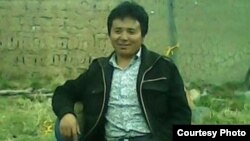Sources tell VOA's Tibetan Service a 43-year-old poet and blogger named Gudrup engulfed himself in flames Thursday in Dreru, Tibet - part of the area China has designated the Tibet Autonomous Region.
Witnesses said Gudrup was badly burned when he was brought to a hospital. A doctor later told them Gudrup had died, but the authorities so far are refusing to release his body to his family.
This past March, Gudrup blogged about the anti-China protests that had gripped southwestern China and Tibet, writing on March 14 "Tibetans who refuse to denounce His Holiness the Dalai Lama or accept China’s rule on Tibet are secretly killed or made to disappear."
In the same post, Gudrup called on fellow Tibetans to "win the battle through truth, by shooting arrows upon our lives."
He also warned Tibetans "are sharpening our nonviolent movement... declaring the reality of Tibet by burning our own bodies to call for freedom."
Gudrup's actions bring the number of self-immolations to 53 since February 2009, and are part of a slowly growing number taking place within the Tibet Autonomous Region. Most of the self-immolations have occurred in southwestern China.
China has repeatedly denounced self-immolations as terrorist acts, calling the practice barbaric. But representatives of the Dalai Lama and the prime minister of the Tibetan government-in-exile say the practice is a sign Tibetans can no longer tolerate Beijing's push against their culture and religion.
"The fact that Tibetans after 50-plus years are still protesting, and in [the] drastic form of self-immolation, clearly indicates that they are protesting against the occupation of Tibet and the repressive policies of the Chinese government," Lobsang Sangay told a gathering in Dharamsala, India last week.
The Tibetan government-in-exile says 51 Tibetans have set themselves on fire since March of 2009 to protest Chinese rule.
China views Tibet as a non-negotiable part of its territory and has long accused the Dalai Lama of trying to separate the Himalayan region from China. The Dalai Lama has said repeatedly that he is not pushing for Tibetan independence, but for greater autonomy.
Tenzin Noryang also contributed to this report.
Witnesses said Gudrup was badly burned when he was brought to a hospital. A doctor later told them Gudrup had died, but the authorities so far are refusing to release his body to his family.
This past March, Gudrup blogged about the anti-China protests that had gripped southwestern China and Tibet, writing on March 14 "Tibetans who refuse to denounce His Holiness the Dalai Lama or accept China’s rule on Tibet are secretly killed or made to disappear."
In the same post, Gudrup called on fellow Tibetans to "win the battle through truth, by shooting arrows upon our lives."
He also warned Tibetans "are sharpening our nonviolent movement... declaring the reality of Tibet by burning our own bodies to call for freedom."
Gudrup's actions bring the number of self-immolations to 53 since February 2009, and are part of a slowly growing number taking place within the Tibet Autonomous Region. Most of the self-immolations have occurred in southwestern China.
China has repeatedly denounced self-immolations as terrorist acts, calling the practice barbaric. But representatives of the Dalai Lama and the prime minister of the Tibetan government-in-exile say the practice is a sign Tibetans can no longer tolerate Beijing's push against their culture and religion.
"The fact that Tibetans after 50-plus years are still protesting, and in [the] drastic form of self-immolation, clearly indicates that they are protesting against the occupation of Tibet and the repressive policies of the Chinese government," Lobsang Sangay told a gathering in Dharamsala, India last week.
The Tibetan government-in-exile says 51 Tibetans have set themselves on fire since March of 2009 to protest Chinese rule.
China views Tibet as a non-negotiable part of its territory and has long accused the Dalai Lama of trying to separate the Himalayan region from China. The Dalai Lama has said repeatedly that he is not pushing for Tibetan independence, but for greater autonomy.
Tenzin Noryang also contributed to this report.

